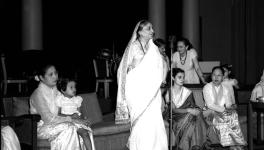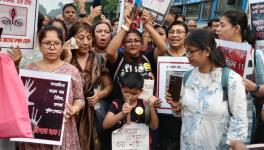Why Rapes Continue to Occur in India Despite Vociferous Protests?

Nationwide protests against the brutal killing of a 31-year-old medical student on August 9 in Kolkata echoed our collective anguish over a yet another rape-and-murder case in the country. Even then, justice continues to elude the victim’s family as the politics, intrigue, and conspiracy surrounding this crime deepen every passing day.
Not surprisingly, various political organisations in West Bengal and Delhi have become embroiled in a war of words, blaming each other over the ghastly incident. Meanwhile, the protests, which initially began on R. G. Kar Medical College in Kolkata, have swiftly spread across India in the form of silent marches and candle light processions.
All of this is eerily reminiscent of the 2012 Nirbhaya case, when the entire nation stood united to cry out against a yet another innocent young woman’s shocking rape and murder in Delhi. In the Kolkata case also, millions of Indians have taken to the streets and voiced their anguish and frustration over the ghastly incident.
While spontaneous and passionate demonstrations in support of women’s safety and women’s rights are an encouraging sign in themselves, they also raise a worrying question: Why do rapes continue to occur in India despite the ever-increasing public protests against this crime?
After every vehement protest against a rape-and-murder-case in India, a few more such cases hit the headlines. For instances, within a few days of the Kolkata case, a teenager was gangraped on a bus in Dehradun within a few days of the Kolkata case, a teenager was gangraped on a bus in Dehradun, Uttarakhand, on August 12. A 10-year old girl was raped and murdered on August 21 in Kolhapur, Maharashtra. On September 12, two Army officers were robbed and their woman friend was gangraped in Bhopal, Madhya Pradesh.
As evident in these instances, the disturbing trend of more rapes and murders, following protests and public outcry against atrocities on women, strongly persists. Nowadays, every headline-making rape feels like a déjà vu! To put it in perspective, according to a recent news channel report, there were 31,516 rape cases registered in India last year; which amounts to 86 cases per day, and four rapes every hour!
Staring in the face of such worrisome numbers, one wonders, why do vociferous protests prove powerless against the rampant rape culture in India? Why do demonstrations and social media campaigns against rape culture achieve little to stymie it? Stating it succinctly, why do protests fail to curb rapes? While there are no easy answers, three factors might explain this stark reality: perception, politics, and patriarchy.
Protests against rape are erroneously perceived by many as an urban phenomenon with an elitist tone attached to it. It is a nefarious perception in itself; nevertheless, it does diminish the power of protests to some extent. Nowadays, thousands of social activists, political affiliates, students, members of voluntary organisations, philanthropists, and conscientious citizens pour out on the roads whenever a rape becomes a headline. Such voluntary outrage against atrocities on women seems representative of contemporary India.
However, it appears that the perpetrators themselves hardly feel deterred by public protests. More protests and more social media coverage do not translate into fewer rape cases. Perhaps, the rapists consider protests against rape a passing phenomenon that rises quickly, garners a lot of attention, and dissipates soon after. Perhaps there is too much visibility, hype, and commotion attached to our
‘protests’ for the felons to see them as foreboding. Perhaps, protests nowadays seem overly urban and sensational to communicate a strong sense of moral condemnation. Perhaps, our protests have become more spectacular and media-friendly to represent and communicate our collective outrage and pain effectively.
So also, the politics attached to rape often deflects the focus away from the crime itself, giving perpetrators a sense of security. While millions of Indians join protests to express their solidarity with the victims and to demand accountability from the government, numerous others participate just to get political mileage out of it. Unfortunately, most rape cases in India become politicised clashes in which vested interests seek to malign their opponents. When politics undermines justice, humanitarian, social, and ethical concerns for the wellbeing of the victims quickly become subsidiary to hidden agendas and power dynamics.
Politicisation of social issues, such as rape and atrocities on women, also neutralises the transformative power of protests and public anger. In such a scenario, the victim’s rights are often overlooked in a bid to politicise the incident. When politics deliberately converts a dehumanising crime into a blame game, the culprits inadvertently benefit from it as legal maneuvers hamper speedy justice. Politicising atrocious crimes only leads to superfluous posturing and sloganeering for calculated gains. As seen time after time in the past decade, when political motives highjack public protests, the rapists roam free, hiding in plain sight, while the victims run for cover in fear and shame.
Similarly, a deeply ingrained patriarchal mindset drives misogynists to employ rape as a form of punishment against women. Traditional patriarchal structures in India still breed an egregious amount of discrimination against women, which encourage men to treat them as inferior, weak, and vulnerable in general.
Worse still, patriarchy also covertly feeds and approves the objectification of women through material and sexual exploitation.
Since a patriarchal mindset considers women’s subjugation a normal social practice, it also treats sexual violence as an effective means of overpowering women. Indian women will continue to become victims of sexual violence, such as rape and murder, so long as the biased patriarchal social systems prevail in India; so long as women remain deprived of the dignity and respect they deserve; so long as they continue to face discrimination and dehumanisation from a male-dominated society. Unfortunately, protests against rapes fail to desist bigoted men from committing sexual crimes against women because the latter remain ensconced within the walls of their misogynist biases.
A brooding sense of doubt over the power of protests to curtail atrocities against women lingers on because of the frequency with which violent crimes continue to occur in India, despite forceful protests after each such incident. While the accused were quickly arrested, convicted, and hanged in the 2012 Nirbhaya case, neither the widespread protests that erupted in its aftermath, nor the fate of the convicts, daunted other rapists across the country.
In the past decade, such heinous crimes have only continued to shock the nation at regular intervals. In particular, the Badaun case in 2014, the Kathua case in 2018, and the Lakhimpur Kheri case in 2022. Young women were subjected to rape and violence in these instances even after much hue and cry over the Nirbhaya case. If the protests, advocacy, and anger that accompanied these crimes had generated even a semblance of deterrence, perhaps, the recent Kolkata rape and murder case would not have occurred at all.
While a faulty perception of public protests persists, while the politics besieging sensationalised rape cases thrives; and while an impervious patriarchal system survives, public outrage alone will never eradicate rape, rape culture, or rapists from India. On the contrary, the rapists seem will continue to develop an immunity to the sociopolitical, legal, and moral pressure exerted by public protests all over the country.
Since protests are reactive by nature, something more proactive is required. Perhaps, a paradigm shift in the way women are perceived, judged, and treated in society might make a difference. It might even become a potent antidote to the menace of rapes in India.
The writer is Assistant Professor of English and Vice-Principal of Arts St. Xavier’s College, Ahmedabad, Gujarat. The views are personal.
Get the latest reports & analysis with people's perspective on Protests, movements & deep analytical videos, discussions of the current affairs in your Telegram app. Subscribe to NewsClick's Telegram channel & get Real-Time updates on stories, as they get published on our website.
























